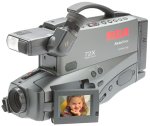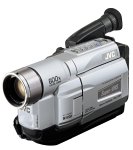| Columbia ISA |
| Home Glossary
|
| Introduction | Links | Formats | Features |
| l | l | Media | Models |
Consumer Video: Camcorders - VHS, VHS-C, S-VHS, S-VHS-C

|
| VHS Video Camcorder |
Compatibility
The big advantage of VHS and
VHS-C camcorders is compatibility. The tapes play in any
standard VCR; you don't need to use the camcorder for
playback. In the case of VHS-C, however, you will need
to use a special adaptor.
This is a full-size VHS cassette with a door into which you
insert the smaller VHS-C cassette.
Formats and
sizes
The first thing to decide is whether you
want full-size VHS or the smaller Compact VHS
(VHS-C). The latter is slightly bigger than the
competing 8mm/Hi8 formats. The big advantage of
full-size VHS is that the tapes will play back on just
about every VHS VCR. The biggest disadvantage, for most
people, is size. These big camcorders are the last thing
you'd want to lug around on a vacation.
Still,
there are times when a full-size VHS camcorder makes
more sense, such as when it will be used by a number of
people — in a school's or an office's A/V department,
for instance. The VHS format saves time and camcorder
wear and tear by eliminating the need to copy recordings
over to VHS (as you would have to do with 8mm and
MiniDV). The same is true for legal depositions, real
estate and other professional applications — the tape
can simply be handed over to a client without
copying.
| VHS-C (compact) For the vast majority of casual camcorder users who want to capture travel, vacations and family, full-size VHS is just too cumbersome. That's where VHS-C comes in. VHS-C tapes require the aforementioned adapter for VCR playback, but it is easily stored in the living room. What's more, additional adapters cost only about $15 to $25. You can buy an adapter for family members so they can watch the original tapes. Of course, the original might get mangled after repeated viewing, or it might be lost in transit. Besides format size, you might also consider paying extra for the higher-resolution Super VHS format. S-VHS and S-VHS-C (the compact version) have more horizontal detail (up to 400 lines) than regular VHS and VHS-C (which have 240 lines). The main disadvantage of these S-VHS formats is that the cassettes are not compatible with standard VCRs (the blanks are also more expensive). You need an S-VHS VCR, or the camcorder itself, for playback. Fortunately, all S-VHS equipment records in regular VHS, too. |
 |
Sound
With VHS and VHS-C,
you must also pay a premium for hi-fi stereo sound.
Unless this feature is specifically mentioned on the
camcorder's case, you can assume that it records audio
using a slender linear track at the edge of the tape,
which has limited frequency response and dynamic range
(especially at the SLP speed, where it sounds truly
horrible). The hi-fi stereo camcorders simultaneously record
the linear track, too, making the tapes fully compatible
with non-hi-fi VCRs.
Flying erase
head
Many VHS-C and VHS camcorders, and
practically all S-VHS-C and S-VHS models, include a flying erase head. This facilitates smooth video
insert edits, in which you replace the picture
while retaining the original sound. It's great for
making low-budget music videos — you can just match
pictures to the song. Learning how to use this feature
may require careful study of the instruction
manual.
Random assemble edit
Many JVC
models include a built-in edit controller called
random assemble edit. It lets you copy several
scenes onto another tape, and it also remotely controls
your VCR.
Override controls
As with all
camcorder formats, you'll pay a premium for manual
override controls (to adjust exposure, white balance
color setting and high/slow-speed shutters), as well as
for microphone and headphone jacks. Most camcorders come
with some form of manual focus, but only the more
expensive Super VHS models have a ring around the lens,
which is the best way to control the manual focus. The
cheaper models run on full
automatic.
Zooms
Look for a lens with a
long optical zoom range. Ignore exaggerated claims for digital
zooms. You'll
never really use this feature because the resultant
picture looks like garbage. At most, digital zoom should
be used for roughly double or triple the optical zoom
ratio. Let's say, for example, that you have a 22x lens.
The most digital zoom you'd need would be 44x or
66x.
Connectivity
Connections on a
VHS-C camcorder range from simple to nonexistent. The
whole idea of this format is to make things easy.
Accordingly, rather than hooking up the actual camcorder
to a TV or VCR for playback, you simply pop the tape
into the supplied VHS adapter and place it into your
VCR. Obviously, you'll also need a VCR to make this
work, but then most people already do. If you don't have
a VCR, think twice before buying a VHS-C camcorder,
because not all models have input/output connections for
playback. Those that do will have standard composite
video and audio jacks (RCA-type) for connection to a VCR
or TV.
Blank media
VHS-C tapes come in
lengths of 20 to 40 minutes, though most commercially
available cassettes are either 30 or 40 minutes. A
decent 30-minute tape can cost less than $3 on the
street; a premium tape, which is more durable and will
occasionally offer better picture quality, costs $5. You can get 60 minutes or more from 8mm or DV
cassettes, and although this means that VHS-C owners
tend to buy more blanks, they don't necessarily spend
more money on them.
VHS adapter
tip
Some words of caution: the VHS adapter is
relatively fragile. Further, the VHS-C tapes themselves
often are delicate. There's a little plastic wheel on
most VHS-C cassettes for taking up any slack in the tape
before you insert it into the adapter. Make sure you use
this wheel. Otherwise, there's a chance that your tape
will get wrinkled or even mangled in the
adapter.
Investing
VHS-C (and the few
remaining full-size VHS models) are among the most
inexpensive camcorders you can buy. As noted earlier,
the idea behind this format is to make camcording cheap
and easy. The theory works most of the time, but you may
end up spending more on blank tapes than do owners of
the 8mm and DV cams.
Recording speed
The original
standard-length VHS-C cassettes can record for 20
minutes at the SP speed. Practically all VHS-C
camcorders (but not full-size VHS models) can record at
the slower SLP speed (also known as EP), which triples
the recording time to one hour for a standard tape.
Thinner tape formulations provide 30 to 40 minutes of
recording time at SP (or triple that at the
lower-quality SLP speed). If, however, you want the best
possible recording quality, stick with 20-minute tapes
at SP speed. These thicker tapes are also less likely to
get mangled.
Taping a steady image
Most VHS and
VHS-C camcorders come with a digital image stabilizer
(DIS) system. Many DIS systems sacrifice a bit of
picture detail. To determine if your DIS is reducing
detail, try switching DIS on and off. If the image
appears to suddenly zoom in a bit when DIS is on, and
zoom out slightly when it's off, then the DIS does
reduce your resolution. Accordingly, you should use it
sparingly. On the other hand, if you see no zoom in/zoom
out, then it may be okay to leave DIS on all the time —
with the proviso that leaving the feature engaged will
drain your battery power more rapidly.
Zoom: blessing
or curse?
The zoom control can be both a blessing
and a curse. The blessing is that a competent user can
get wide, medium and close-up shots from a single
vantage point without moving the camera. The curse is
that in the hands of an inexperienced user, none of
those shots are ever seen — at least not for more than a
second or two. Instead, the amateur user keeps zooming
the lens, going back and forth incessantly and never
settling on what filmmakers call a shot.
The best
uses of zooms are subtle ones — tighten ever so slightly
on someone's face as they speak, for instance. (When
shopping for a camcorder, look for models with very slow
zoom speeds. Most models nowadays have variable speed,
but the slowest setting ranges from 8 to 20 seconds for
a full sweep of the optical range).
Viewing
systems
Most of today's VHS-C camcorders have
dual viewing systems: a regular viewfinder
and a viewscreen. The color viewscreen (typically
around 3") is fun to use, plus it lets you see yourself
while shooting (also known as "self record"). Kids love
to see themselves on the screen. What's more, the big
screens make it easy to hold the camcorder low to get a
child's-eye perspective, or, for that matter, overhead
to see beyond a crowd.
But these viewscreens can
appear totally washed out in bright, outdoor light. This
is why the dual-viewing design is so popular — the
traditional viewfinder serves as a backup. You may also
find there are times when you prefer to use the
viewfinder for privacy reasons — if, for instance, you
don't want onlookers to see what you're
taping.
Editing
Most people never get
around to editing their tapes later. As such,
on-the-spot in-camera editing is the quickest and
easiest way to create tapes that are at least halfway
interesting enough to share with your family and
friends. Some of the more advanced VHS and Super-VHS
models (those with flying erase heads) offer
quite a few in-camera editing tricks, including video
insert editing and audio dubbing. You may,
however, still find it difficult and sometimes
impossible to do the most obvious thing — putting new
material in the place of previously recorded material
without creating a glitch at the end of the edit.
(Tip: Look for an "A/V insert edit" feature in
your owner's manual.)
Audio dubbing is
widely available in VHS (and many VHS-C) models. It
works only with the linear (monaural) audio track and is
especially useful on hi-fi stereo camcorder models
because it allows you to add a new track while retaining
the original audio on the hi-fi tracks. You can thus mix
music or narration in with the original sound, though
you'll need a special "mix" mode to hear both tracks
together.
Columbia ISA
Empowering consumers thru information
Contact: [email protected]